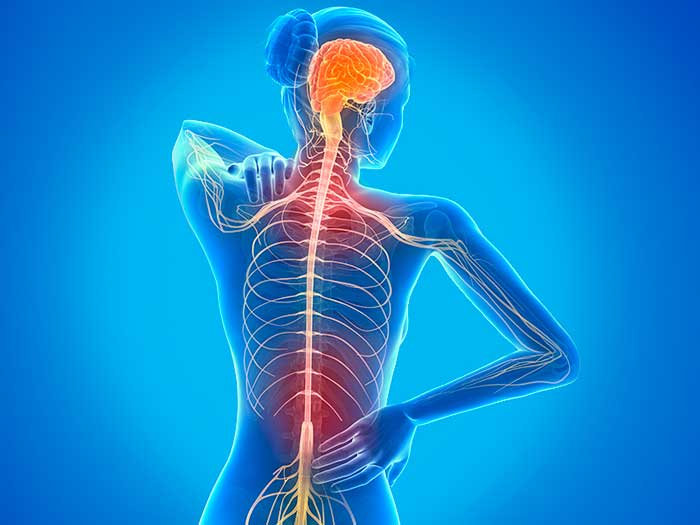 If you think that sclerosis can only happen at senile age, you are both mistaken and lucky. It means that you have not experienced this disease, although it can occur in 20-year-olds. Geniusbeauty.com will tell you how the immune system attacks your own brain and what symptoms you should be afraid of.
If you think that sclerosis can only happen at senile age, you are both mistaken and lucky. It means that you have not experienced this disease, although it can occur in 20-year-olds. Geniusbeauty.com will tell you how the immune system attacks your own brain and what symptoms you should be afraid of.
What is sclerosis?
The term is coined from the Greek word skleros (solid) and means the process of compacting various organs and tissues, replacing their elements with fibrous (connective) tissue.
Multiple sclerosis is a chronic disease of the nervous system, in which there are multiple scattered foci of demyelination (destruction of myelin) in the white matter of the brain and spinal cord. The symptoms of the disease have nothing to do with senile dementia, and the human intellect, as a rule, remains intact.
Multiple sclerosis is autoimmune damage to the nervous system, in which the human immune system mistakenly takes the white matter of the brain (mainly myelin – the nerve sheath) for an alien structure and begins to fight with it.
Risk factors
The number of patients with autoimmune diseases is increasing every year, as people are less in contact with nature, and the immune system receives less and less pressure from the outside. There is no single cause of multiple sclerosis, however, there are a number of factors that can increase its likelihood.
These factors include: living in the northern latitudes (Russia, Canada, and the Scandinavian countries demonstrate the highest incidence in the world), vitamin D deficiency, belonging to a Caucasoid race and genetic predisposition.
Unfortunately, the symptoms, clearly associated with multiple sclerosis, have not been discovered by now. There are only markers of a general propensity for autoimmune diseases. Patients with multiple sclerosis often have similar illnesses, for example, bronchial asthma and autoimmune diseases of the thyroid gland.
Alarms
Most often, the first signs of multiple sclerosis occur in people aged 20 to 30 years. It can also be first diagnosed in older people and children, but it happens much less frequently. The patient may experience weakness in the arms and/or legs, worsened vision, and disturbed coordination.
The main threat of the disease is that without treatment, multiple sclerosis will progress and interfere in everyday life greatly: coordination of movements can be disturbed, the gait can become shaky and unstable, there can be difficulties in making subtle movements, such as handwriting, makeup or manicure, handicraft. One can suffer from reduced clarity of view and focus on objects in one or both eyes. It becomes more difficult to follow movements. In the future, these violations can become so pronounced that a person will not do without help.
If you suspect multiple sclerosis, it is important to consult a doctor as soon as possible, because the earlier the disease is diagnosed and the specific treatment is chosen, the less severe the symptoms will be.
Course of disease
The course of the disease is usually wavy: periods of exacerbation, when the patient experiences some kind of disturbance, are replaced by longer periods of remission when he feels well, is active and is socially adapted. Usually, exacerbations last up to a month and occur once or twice a year, but in some patients, they may be more frequent. In particular, it can trigger stress or a viral disease. After each exacerbation, a person may experience some kind of impairment, for example, the vision, mobility of the arm or legs may not fully recover.
The disease is chronic, so it cannot be completely cured, but modern drugs and the correct scheme of their purpose can keep multiple sclerosis in the inactive phase. That is, the task of treatment is to increase the periods of remission as much as possible, reduce the frequency of exacerbations, and, if possible, completely stop them. In the case of proper therapy, patients with this disease do not experience severe negative manifestations throughout their lives, and exacerbations may be absent for several years.
Women with multiple sclerosis may have children – as a rule, the disease does not manifest itself during pregnancy, and the expectant mother only needs more careful observation. The young mother can face problems immediately after birth, so experts recommend limiting the period of breastfeeding to two to three months and immediately resume treatment.
What are the symptoms of multiple sclerosis?
The symptoms of multiple sclerosis are similar to manifestations of other diseases, so only a doctor can make a correct diagnosis. If you have reduced vision in one eye, as if a gray or white veil has appeared in front of it, numbness or weakness in the arms or legs, dizziness occurs with the rotation of objects clockwise or counterclockwise, be sure to consult a neurologist to rule out neurological diseases, including multiple sclerosis.
It is important to know that a person becomes somewhat euphoric, less critical of his condition and may not attach importance to changes in gait or vision due to the illness. When closest relatives notice the first manifestations of multiple sclerosis in a loved one at a young age, you should send him to a neurologist for consultation, even if these symptoms do not bother him.



